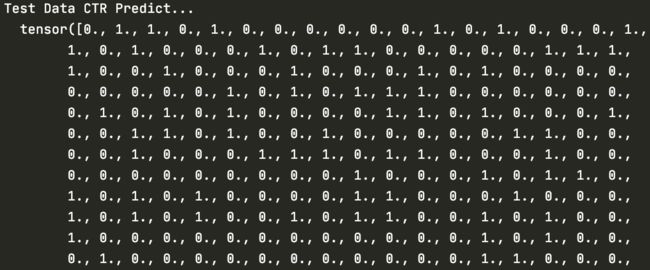简介
本文要介绍的是由浙江大学联合新加坡国立大学提出的AFM模型。通过名字也可以看出,此模型又是基于FM模型的改进,其中A代表”Attention“,即AFM模型实际上是在FM模型中引入了注意力机制改进得来的。之所以要在FM模型中引入注意力机制,是因为传统的FM模型对所有的交叉特征都平等对待,即每个交叉特征的权重都是相同的(都为1)。而在实际应用中,不同交叉特征的重要程度往往是不一样的。如果”一视同仁“地对待所有的交叉特征,不考虑不同特征对结果的影响程度,事实上消解了大量有价值的信息。
关于FM模型,可以参考推荐系统之FM(因子分解机)模型原理以及代码实践。
推荐系统中的注意力机制
这里再举个例子,说明一下注意力机制是如何在推荐系统中派上用场的。注意力机制基于假设——不同的交叉特征对结果的影响程度不同,以更直观的业务场景为例,用户对不同交叉特征的关注程度应该是不同的。举例来说,如果应用场景是预测一位男性用户是否会购买一款键盘的可能性,那么”性别=男”和“购买历史包含鼠标“这一交叉特征,很可能比”性别=男”和“年龄=30“这一交叉特征重要,模型应该投入更多的”注意力“在前面的特征上。正因如此,将注意力机制引入推荐系统中也显得理所当然了。
模型
在介绍AFM模型之前,先给出FM模型的方程:
其中 代表全局偏置, 代表第 个特征的权重, 代表交叉特征 的权重,它可以被表示为: ,其中 代表第 个特征的embedding向量, 代表embedding向量的维度。由于存在系数 ,因此FM只能考虑两个均不为0的特征之间的交互。我们注意到,在FM中,所有的交叉特征 都具有相同的权重系数1,这可能会导致FM模型的泛化能力的下降,这也正是AFM需要改进的地方。Pair-wise 交互层
Pair-wise 交互层将个向量扩展到个交叉向量,每个交叉向量都是通过对两个不同的向量进行内积来计算的。可以通过以下公式来描述:
即对任意两个不同时为0的特征 ,计算它们的乘积以及它们对应的embedding向量的乘积,最后再相乘起来。 个向量之间一共可以产生 个不同的交叉特征向量。其实这样做是为了在神经网络架构下模拟FM中的交叉特征项。然后我们可以将 通过一个求和池化层,再通过一个全连接层映射成最终的预测分数: 如果我们令 ,那么我们就能完全还原FM模型。这里其实跟NFM模型的核心操作类似,具体可以参考推荐系统之NFM模型原理以及代码实践。
Attention-based Pooling层
下面看一下作者是如何将注意力机制加入到FM模型中去的。其实也很简单,只是在上述的交叉特征项前加入了注意力分数权重,具体如下:
其中 就是交叉特征 的注意力分数,它可以被看做是在预测过程中 的重要程度。
为了估计 ,一个很自然的想法就是通过直接最小化目标损失函数来估计,在技术上似乎也是可行的。但是,对于从未在训练集中出现的共同出现过的特征,那么意味着 ,故对应的注意力分数 不可能通过估计得到。
为了解决这个问题,作者提出了通过MLP来参数化注意力分数,作者称之为”注意力网络“,其定义如下: 其中要学习的模型参数就是特征交叉层到注意力网络全连接层的权重 ,偏置向量 ,以及全连接层到Softmax输出层的权重向量 。注意力网络将于整个模型一起参与到梯度反向传播的过程,得到最终的权重参数。
直观来看,注意力网络就是将交叉特征首先通过一个全连接层,接着通过Relu激活函数,再乘以权重参数得到,接着再通过一个Softmax层,将其映射成注意力权重,此时有。
AFM模型
下面给出完整的AFM框架图:
其中绿色的方框代表的就是”注意力网络“,绿色箭头代表的是计算顺序。得到了交叉特征之后,先通过”注意力网络“获得注意力分数 ,然后再将交叉特征乘以注意力分数 ,再求和,即求和池化操作,最后得到预测分数。AFM模型的整体方程为: 模型的总参数 。代码实践
模型部分:
import torch
import torch.nn as nn
from BaseModel.basemodel import BaseModel
class AFM(BaseModel):
def __init__(self, config, dense_features_cols, sparse_features_cols):
super(AFM, self).__init__(config)
self.num_fields = config['num_fields']
self.embed_dim = config['embed_dim']
self.l2_reg_w = config['l2_reg_w']
# 稠密和稀疏特征的数量
self.num_dense_feature = dense_features_cols.__len__()
self.num_sparse_feature = sparse_features_cols.__len__()
# AFM的线性部分,对应 ∑W_i*X_i, 这里包含了稠密和稀疏特征
self.linear_model = nn.Linear(self.num_dense_feature + self.num_sparse_feature, 1)
# AFM的Embedding层,只是针对稀疏特征,有待改进。
self.embedding_layers = nn.ModuleList([
nn.Embedding(num_embeddings=feat_dim, embedding_dim=config['embed_dim'])
for feat_dim in sparse_features_cols
])
# Attention Network
self.attention = torch.nn.Linear(self.embed_dim, self.embed_dim, bias=True)
self.projection = torch.nn.Linear(self.embed_dim, 1, bias=False)
self.attention_dropout = nn.Dropout(config['dropout_rate'])
# prediction layer
self.predict_layer = torch.nn.Linear(self.embed_dim, 1)
def forward(self, x):
# 先区分出稀疏特征和稠密特征,这里是按照列来划分的,即所有的行都要进行筛选
dense_input, sparse_inputs = x[:, :self.num_dense_feature], x[:, self.num_dense_feature:]
sparse_inputs = sparse_inputs.long()
# 求出线性部分
linear_logit = self.linear_model(x)
# 求出稀疏特征的embedding向量
sparse_embeds = [self.embedding_layers[i](sparse_inputs[:, i]) for i in range(sparse_inputs.shape[1])]
sparse_embeds = torch.cat(sparse_embeds, axis=-1)
sparse_embeds = sparse_embeds.view(-1, self.num_sparse_feature, self.embed_dim)
# calculate inner product
row, col = list(), list()
for i in range(self.num_fields - 1):
for j in range(i + 1, self.num_fields):
row.append(i), col.append(j)
p, q = sparse_embeds[:, row], sparse_embeds[:, col]
inner_product = p * q
# 通过Attention network得到注意力分数
attention_scores = torch.relu(self.attention(inner_product))
attention_scores = torch.softmax(self.projection(attention_scores), dim=1)
# dim=1 按行求和
attention_output = torch.sum(attention_scores * inner_product, dim=1)
attention_output = self.attention_dropout(attention_output)
# Prodict Layer
# for regression problem with MSELoss
y_pred = self.predict_layer(attention_output) + linear_logit
# for classifier problem with LogLoss
# y_pred = torch.sigmoid(y_pred)
return y_pred
在criteo数据集上测试,测试代码如下:
import torch
from AFM.network import AFM
from DeepCrossing.trainer import Trainer
import torch.utils.data as Data
from Utils.criteo_loader import getTestData, getTrainData
afm_config = \
{
'num_fields': 26, # 这里配置的只是稀疏特征的个数
'embed_dim': 8, # 用于控制稀疏特征经过Embedding层后的稠密特征大小
'seed': 1024,
'l2_reg_w': 0.001,
'dropout_rate': 0.1,
'num_epoch': 200,
'batch_size': 64,
'lr': 1e-3,
'l2_regularization': 1e-4,
'device_id': 0,
'use_cuda': False,
'train_file': '../Data/criteo/processed_data/train_set.csv',
'fea_file': '../Data/criteo/processed_data/fea_col.npy',
'validate_file': '../Data/criteo/processed_data/val_set.csv',
'test_file': '../Data/criteo/processed_data/test_set.csv',
'model_name': '../TrainedModels/AFM.model'
}
if __name__ == "__main__":
####################################################################################
# AFM 模型
####################################################################################
training_data, training_label, dense_features_col, sparse_features_col = getTrainData(afm_config['train_file'], afm_config['fea_file'])
train_dataset = Data.TensorDataset(torch.tensor(training_data).float(), torch.tensor(training_label).float())
test_data = getTestData(afm_config['test_file'])
test_dataset = Data.TensorDataset(torch.tensor(test_data).float())
afm = AFM(afm_config, dense_features_cols=dense_features_col, sparse_features_cols=sparse_features_col)
####################################################################################
# 模型训练阶段
####################################################################################
# # 实例化模型训练器
trainer = Trainer(model=afm, config=afm_config)
# 训练
trainer.train(train_dataset)
# 保存模型
trainer.save()
####################################################################################
# 模型测试阶段
####################################################################################
afm.eval()
if afm_config['use_cuda']:
afm.loadModel(map_location=lambda storage, loc: storage.cuda(afm_config['device_id']))
afm = afm.cuda()
else:
afm.loadModel(map_location=torch.device('cpu'))
y_pred_probs = afm(torch.tensor(test_data).float())
y_pred = torch.where(y_pred_probs>0.5, torch.ones_like(y_pred_probs), torch.zeros_like(y_pred_probs))
print("Test Data CTR Predict...\n ", y_pred.view(-1))
完整代码见:https://github.com/HeartbreakSurvivor/RsAlgorithms/tree/main/AFM。
参考
- 《深度学习推荐系统》-- 王喆
- Attentional Factorization Machines: Learning the Weight of Feature Interactions via Attention Networks
- https://github.com/shenweichen/DeepCTR-Torch/blob/e7d52151ed3c8beafeda941051aecc6294a4a20d/deepctr_torch/layers/interaction.py#L250
- https://www.cnblogs.com/sunupo/p/12862852.html







